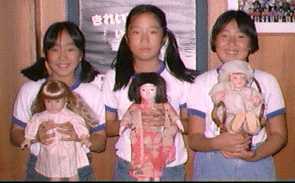|
Main Page
Children's Page |
|
Other Friendship Doll Programs
Mukogawa Fort Wright Institute Sidney and Frances Gulick Urayasu Friendship Doll Exchange Association |
Other Friendship Doll Programs

|
|
|
|
Japanese students holding |
The exchange of dolls between America and Japan did not end with the Friendship Dolls exchanged in 1927. Many individuals and groups have been involved in sending new dolls, especially during the last 15 years.
Three programs have had a very significant impact on the lives of children in Japan and America:
- Mukogawa Fort Wright Institute - Since 1993, this organization has sent over 1,000 Japanese dolls to schools in every state of the US.
- Sidney and Frances Gulick - Following in the footsteps of his grandfather, Sidney Gulick, 3d, and his wife Frances have sent many American dolls to Japanese schools since 1986.
- Urayasu Friendship Doll Exchange Association - Inspired by Dr. Gulick's 1927 Friendship Doll Mission, residents of Urayasu City vow never to repeat war, and they launch a movement to send dolls to children worldwide with the formation of the Urayasu Friendship Doll Exchange Association. In addition, junior high school students, as a part of international understanding education, make hand-made dolls, kimonos, and passports; attach letters; and send the dolls.
Besides these three friendship dolls programs, many other individuals, schools, and organizations have also been involved in sending dolls to children in schools in Japan and America. For example, the former J.A.D.E. (Japanese Asian Doll Enthusiasts) group sent over a dozen dolls to Japanese schools. They also had several members of their organization who gave lectures on Japanese culture to schools and other organizations in the United States.
In 2002, the Japanese American National Museum sent new Friendship Dolls to the children of Japan as a thank-you gesture for lending the museum their dolls for a special Friendship Doll exhibition. Allyson Nakamoto, Head of the Educational Components Department at the museum, explains about the dolls to be sent:
One of these dolls, Maria, was sent to us by Dr. Sidney Gulick, 3d, and his wife, Dr. Frances Gulick. Maria and the six dolls chosen by the National Museum show the diversity of the United States not only in ethnicity, but also in vocation. For example, we are sending an African American veterinarian, an Asian American girl, and a European American soccer player. It is our hope that these dolls capture the hearts and midst of the Japanese children, just like their 1927 predecessors.